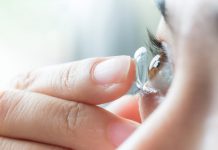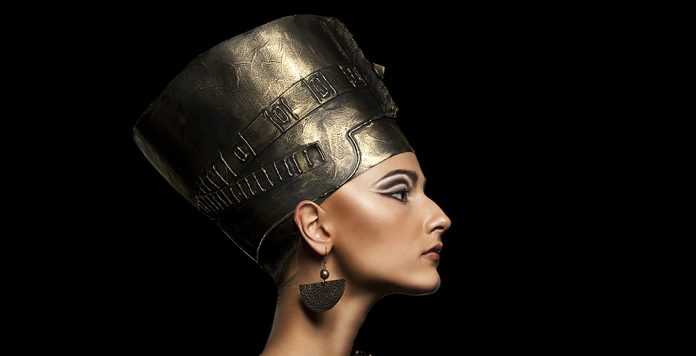A HISTORY OF COSMETICS FROM ANCIENT TIMES
Civilizations have used cosmetics – though not always recognizable compared to today’s advanced products – for centuries in religious rituals, to enhance beauty, and to promote good health. Cosmetics usage throughout history can be indicative of a civilization’s practical concerns, such as protection from the sun, indication of class, or conventions of beauty. The timeline below represents a brief history of cosmetics, beginning with the Ancient Egyptians in 10,000 BCE through modern developments in the United States. You can use the following navigation to jump to specific points in time.
COSMETICS THROUGH THE AGES
COSMETICS IN THE ANCIENT WORLD
COSMETICS IN THE EARLY COMMON ERA
COSMETICS IN THE MIDDLE AGES
RENAISSANCE COSMETICS
19TH AND EARLY 20TH CENTURY GLOBAL COSMETICS DEVELOPMENTS
IMPORTANT INDUSTRY DEVELOPMENTS IN THE UNITED STATES
GROWTH OF THE INDUSTRY
WORLD WAR I & AFTERMATH
THE ROARING 20s
THE GREAT DEPRESSION
WORLD WAR II & AFTERMATH
THE MODERN ERA OF COSMETICS
THE 1970s
THE 1980s
THE 1990s
THE 2000s
COSMETICS THROUGH THE AGES
Cosmetics in the Ancient World
10,000 BCE:
Cosmetics are an integral part of Egyptian hygiene and health. Men and women in Egypt use scented oils and ointments to clean and soften their skin and mask body odor. Oils and creams are used for protection against the hot Egyptian sun and dry winds. Myrrh, thyme, marjoram, chamomile, lavender, lily, peppermint, rosemary, cedar, rose, aloe, olive oil, sesame oil, and almond oil provide the basic ingredients of most perfumes Egyptians use in religious rituals.
4000 BCE:
Egyptian women apply galena mesdemet (made of copper and lead ore) and malachite (bright green paste of copper minerals) to their faces for color and definition. They use kohl (a combination of burnt almonds, oxidized copper, different colored coppers ores, lead, ash, and ochre) to adorn the eyes in an almond shape. Women carry cosmetics to parties in makeup boxes and keep them under their chairs.
3000 BCE:
The Chinese stain their fingernails with gum arabic, gelatin, beeswax, and egg. The colors are used as a representation of social class: Chou dynasty royals wear gold and silver, with subsequent royals wearing black or red. Lower classes are forbidden to wear bright colors on their nails.
Grecian women paint their faces with white lead and apply crushed mulberries as rouge. The application of fake eyebrows, often made of oxen hair, is also fashionable.
1500 BCE:
Chinese and Japanese citizens commonly use rice powder to make their faces white. Eyebrows are shaved off, teeth are painted gold or black, and henna dyes are applied to stain hair and faces.
1000 BCE:
Grecians whiten their complexion with chalk or lead face powder and fashion crude lipstick out of ochre clays laced with red iron.
Cosmetics in the Early Common Era (CE)
100:
In Rome, people put barley flour and butter on their pimples and sheep fat and blood on their fingernails for polish. In addition, mud baths come into vogue, and some Roman men dye their hair blonde.
300-400:
Henna is used in India both as a hair dye and in mehndi, an art form in which complex designs are painted on the hands and feet using a paste made from the henna plant, especially before a Hindu wedding. Henna is also used in some North African cultures.
Cosmetics in the Middle Ages
1200:
Perfumes are first imported to Europe from the Middle East as a result of the Crusades.
1300:
In Elizabethan England, dyed red hair comes into fashion. Society women wear egg whites over their faces to create the appearance of a paler complexion. Some people believe, however, that cosmetics blocked proper circulation and therefore pose a health threat.
Renaissance Cosmetics
1400-1500:
Italy and France emerge as the main centers of cosmetics manufacturing in Europe, and only the aristocracy has access. Arsenic is sometimes used in face powder instead of lead. The modern notion of complex scent-making evolves in France. Early fragrances are amalgams of naturally occurring ingredients. Later, chemical processes for combining and testing scents surpass their arduous and labor-intensive predecessors.
1500-1600:
European women often attempt to lighten their skin using a variety of products, including white lead paint. Queen Elizabeth I of England is one well-known user of white lead, with which she creates a look known as “the Mask of Youth.” Blonde hair rises in popularity as it is considered angelic. Mixtures of black sulfur, alum, and honey are painted onto the hair and lighten with sun exposure.
19th and Early 20th Century Global Cosmetics Developments
1800:
Zinc oxide becomes widely used as a facial powder, replacing the previously used deadly mixtures of lead and copper. One such mixture, Ceruse, which is made from white lead, is later discovered to be toxic and blamed for health problems including facial tremors, muscle paralysis, and even death.
Queen Victoria publicly declares makeup improper. It is viewed as vulgar and acceptable only for use by actors.
1900:
In Edwardian Society, pressure increases on middle-aged women to appear youthful while acting as hostesses. As a result, cosmetics use increases, but is not yet completely popularized.
Beauty salons rise in popularity, though patronage of such salons is not widely accepted. Because many women do not wish to publicly admit they have assistance achieving their youthful appearances, they often enter salons through the back door.
IMPORTANT COSMETICS INDUSTRY DEVELOPMENTS IN THE UNITED STATES
From its earliest days, the United States has been at the forefront of cosmetics innovation, entrepreneurship, and regulation. The timeline below represents a brief history of the important developments and American usage trends, as well as a regulatory history of cosmetics in the U.S.
Growth of the Industry
1886:
David McConnell founds the California Perfume Company (CPC), then located in New York. Over time, the company continues to grow and experiences great success, selling five million units in North America during World War I alone. In 1928, CPC sells its first products – toothbrush, powdered cleanser, and a vanity set – under the name by which it is commonly known today: Avon. The Avon line of cosmetics was introduced the next year, in 1929.
1894:
The extremely competitive nature of the industry drives a group led by New York perfumer Henry Dalley to found the Manufacturing Perfumers’ Association. The group evolved over time and, after several name changes, is now known as the Personal Care Products Council (PCPC).
1900:
The number of U.S. firms manufacturing perfumery and toilet goods increases from 67 (in 1880) to 262. By 1900, cosmetics are in widespread use around the world, including the United States.
1907:
Eugene Schueller, a young French chemist, invents modern synthetic hair dye which he calls “Oréal.” In 1909, Schueller names his company Societe Francaise de Teintures Inoffensives pour Cheveux (Safe Hair Dye Company of France), which today has become L’Oréal.
1910:
American women begin to fashion their own form of mascara by applying beads of wax to their eyelashes.
World War I & Aftermath
1914:
The onset of World War I leads to increased employment among American women. This gain in disposable income, with more discretion over its use, leads to a boom in domestic cosmetics sales.
1915:
Chemist T.L. Williams creates Maybelline Mascara for his sister, Mabel, the product’s inspiration.
1919:
Congress passes the 18th Amendment to the U.S. Constitution, commonly known as Prohibition. As originally drafted, the Amendment might have outlawed perfumes and toilet goods because of their alcohol content. The Manufacturing Perfumers’ Association (MPA), however, mobilized its forces and persuaded Congress to clarify the language to exempt products unfit for use as beverages.
The Roaring 20s
1920:
The flapper look comes into fashion for the first time and, with it, increased cosmetics use: dark eyes, red lipstick, red nail polish, and the suntan, which is first noted as a fashion statement by Coco Chanel.
Cosmetics and fragrances are manufactured and mass marketed in America for the first time.
Max Factor, a Polish-American cosmetician and former cosmetics expert for the Russian royal family, invents the word “makeup” and introduces Society Makeup to the general public, enabling women to emulate the looks of their favorite movie stars.
1920-1930:
The first liquid nail polish, several forms of modern base, powdery blushes, and the powder compact are introduced.
1922:
The Manufacturing Perfumers’ Association (MPA) changes its name to the American Manufacturers of Toilet Articles (AMTA).
1928:
Max Factor, now living in Hollywood, unveils the very first lip-gloss.
1929:
A pound of face powder was sold annually for every woman in the U.S. and there were more than 1,500 face creams on the market. The concept of color harmony in makeup was introduced simultaneously, and major cosmetics companies began producing integrated lines of lipsticks, fingernail lacquers, and foundations.
The Great Depression
1930:
Due to the influence of movie stars, the Hollywood “tan” look emerges and adds to the desire for tanned skin, first made popular by fashion designer Coco Chanel, who accidentally got sunburnt visiting the French Riviera in 1923. When she arrived home, her fans apparently liked the look and started to adopt darker skin tones themselves.
1932:
In the midst of the Great Depression, brothers Charles and Joseph Revson, along with chemist Charles Lachman, found Revlon, after discovering a unique manufacturing process for nail enamel, using pigments instead of dyes. This innovation was ultimately responsible for Revlon’s success; it became a multimillion dollar corporation within just six years. Revlon also borrowed the concept of “planned obsolescence” from General Motors Corp. to introduce seasonal color changes. Until World War II, women tended to use an entire lipstick or bottle of nail polish before purchasing a new one.
1934:
Drene, the first detergent-based shampoo, is introduced into the marketplace by Procter & Gamble.
1935:
Max Factor develops and introduces pancake makeup to meet the unique requirements of Technicolor film. When actresses started taking it home for personal use, he realized his new invention looked wonderful both on and off camera and decided to introduce pancake makeup to the general retail trade.
1936:
Eugene Schueller (founder of L’Oréal) invents the first sunscreen. Despite its relative ineffectiveness, this development leads to the invention of Glacier Cream by Austrian scientist, Franz Greiter. Introduced in 1938, this product is cited as the first commercially viable sun protection cream. In 1962, Greiter introduced the concept for the Sun Protection Factor rating system (SPF), which has since become the worldwide standard for measuring the effectiveness of sunscreen.
1938:
Cosmetics were excluded from the Pure Food & Drug Act of 1906 because they were not considered a serious public health concern. However, an incident linked to use of an eyeliner product forced Congress to pass the Federal Food, Drug, and Cosmetic (FD&C) Act, which greatly expanded FDA’s authority to regulate cosmetics.
World War II & Aftermath
1940:
Leg makeup is developed in response to a shortage of stockings during World War II.
The FDA is transferred from the Department of Agriculture to the Federal Security Agency and Walter G. Campbell is appointed the first Commissioner of Food and Drugs.
1949:
Companies such as Procter & Gamble (who made products such as soap and laundry detergents) begin to sponsor daytime television programs that will eventually be called “soap operas,” the first of which was called These Are My Children.
The Modern Era of Cosmetics
1950:
The Modern Era of the cosmetics business begins as television advertising is first implemented in earnest.
1952:
Mum, the first company to commercially market deodorant, launches the first roll-on deodorant (under the brand name of Ban Roll-On), which is inspired by the design of another recently invented product – the ballpoint pen.
1955:
Crest, the first toothpaste with fluoride clinically proven to fight cavities, is introduced by Procter & Gamble.
1960:
Congress passes the Color Additive Amendments, in response to an outbreak of illnesses in children caused by an orange Halloween candy, which requires manufacturers to establish the safety of color additives in foods, drugs, and cosmetics. The Amendments included a provision called the “Delaney Clause’” that prohibited the use of color additives shown to be a human or animal carcinogen.
“Natural” products based on botanical ingredients, such as carrot juice and watermelon extract, were first introduced. False eyelashes became popular.
1965:
The first aerosol deodorant is introduced – Gillette’s Right Guard.
1966:
Congress enacts the Fair Packaging and Labeling Act (FPLA), which requires all consumer products in interstate commerce to be honestly and informatively labeled, with FDA enforcing provisions on foods, drugs, cosmetics, and medical devices.
The 1970s
1970:
The Toilet Goods Association (TGA) changes its name to the Cosmetic, Toiletry, and Fragrance Association (CTFA).
1971:
In response to a citizen petition filed by the CTFA, the FDA Office of Colors and Cosmetics established the Voluntary Cosmetic Reporting Program (VCRP) in 1971. The VCRP is an FDA post-market reporting system for use by manufacturers, packers, and distributors of cosmetic products that are in commercial distribution in the United States; it demonstrated the industry’s commitment to cosmetic safety and furthered the safety evaluation of cosmetic ingredients.
1973:
CTFA establishes the International Cosmetic Ingredient Nomenclature Committee (INC) – comprised of dedicated scientists from industry, academia, regulatory authorities and sister trade associations – to develop and assign uniform names for cosmetic ingredients. “INCI” names are uniform, systematic names internationally recognized to identify cosmetics ingredients that are published biennially in the International Cosmetic Ingredient Dictionary and Handbook.
The environmental movement brings challenges to the cosmetics and fragrance industry. The use of some popular ingredients, including musk and ambergris, is banned following the enactment of endangered species protection legislation.
1976:
CTFA, with the support of the FDA and the Consumer Federation of America, establishes the Cosmetic Ingredient Review (CIR) Expert Panel. The goal of the CIR is to bring together worldwide published and unpublished data on the safety of cosmetics ingredients, and for an independent expert panel to subsequently review that data. The seven-member panel consists of scientists and physicians from the fields of dermatology, pharmacology, chemistry, and toxicology selected by a steering committee and publicly nominated by government agencies, industry, and consumers. The panel thoroughly reviews and assesses the safety of ingredients and ultimately publishes the final results in the peer-reviewed International Journal of Toxicology. Today, CIR has reviewed thousands of the most commonly used cosmetics ingredients.
The 1980s
1980:
The 80’s saw a dramatic change from previous decades where women typically wore makeup that was natural and light. Instead, the new order of the day was to experiment with heavy layers of bold, bright colors. Gone was the golden glow of the 70’s, replaced by foundation that was one or two shades lighter than women’s natural skin tone. Smokey eyes in bright colors such as fuchsia, electric blue, orange, and green were hugely popular. The 80’s was all about taking your look to the extreme, championed by superstars such as Madonna and Cyndi Lauper.
Concerns about contaminated makeup emerged late in the decade. An FDA report in 1989 found that more than five percent of cosmetics samples collected from department store counters were contaminated with mold, fungi, and pathogenic organisms.
1981:
PCPC donates $1 million to fund a national center for the development of alternatives to animal testing – the Johns Hopkins School Center for Alternatives to Animal Testing (CAAT). Its mission is to promote and support research in animal testing alternatives. To date, CAAT has funded to approximately 300 grants totaling more than $6 million.
1989:
Look Good Feel Better is founded by the Look Good Feel Better Foundation (formerly the Personal Care Products Council Foundation) – a charitable organization established by CTFA to help hundreds of thousands of women with cancer by improving their self-esteem and confidence through lessons on skin and nail care, cosmetics, and accessories to address the appearance-related side effects of treatment.
The 1990s
1990:
Animal testing for cosmetics continues to be a hot topic in the beauty industry, driven by consumer preferences. In June 1989, Avon became the first major cosmetics company in the world to announce a permanent end to animal testing of its products, including testing done in outside laboratories. Other companies subsequently follow suit throughout the next decade and efforts intensify to develop and gain governmental approvals for alternative methods to substantiate product safety.
1999:
The first ever Cosmetics Harmonization and International Cooperation (CHIC) meeting is held in Brussels, Belgium. At the conference, representatives from the U.S. FDA; the Japanese Ministry of Health, Labour, and Welfare (MHLW); Health Canada; and Directorate General III of the European Union discuss broad cosmetics topics, including: basic safety substantiation, exchange of data and information, development of an international alert system, and an international memorandum of cooperation.
The 2000s
2000:
Consumers in the early 2000s are pressed for time. As the pace of work and home life became more stressful and hectic, cosmetics and personal care products that emphasized relaxation, but which could still be used quickly, constituted a strong category within the industry. Among these products are aromatherapy scented body washes, as well as other liquid and gel soaps, which start to replace traditional bar soaps.
The industry experiences increased challenges including product safety concerns, calls for scientific data to document product claims, increasing environmental concerns, and pressure from the growing animal rights movement. Congress began investigating possible revisions to the traditional “drug” and “cosmetic” definitions established under the Food, Drug, and Cosmetic Act.
2004:
The European Union (EU) implements an animal testing ban on finished cosmetics products.
2006:
The CTFA develops the Consumer Commitment Code, which highlights the voluntary, proactive, and responsible approach to product safety supported by cosmetics companies. The Code is intended to enhance confidence and transparency for consumers and government regulators.
2007:
The Cosmetic, Toiletry, and Fragrance Association (CTFA) changes its name to the Personal Care Products Council (PCPC). PCPC supports numerous legislative initiatives in the states of California, Massachusetts and New York, and launches Cosmeticsinfo.org to assist consumers in understanding the products they use as well as the industry’s record of safety in the formulation of those products.
The International Cooperation on Cosmetics Regulation (ICCR) is established, comprised of a voluntary, international group of cosmetics regulatory authorities from Brazil, Canada, the European Union, Japan, and the United States. This group of regulatory authorities meets on an annual basis to discuss common issues on cosmetics safety and regulation.
2009:
The European Commission (EC) issues regulation governing product claims, protecting consumers from misleading claims concerning efficacy and other characteristics of cosmetic products.
2010:
PCPC commissions a study to help quantify the important contributions the cosmetics industry makes to the economy and society. The findings illustrate the deep commitment of personal care leaders to promote and advance environmental, social, and economic benefits to its consumers.
2012:
PCPC begins working with FDA and Congressional staff on a multi-year process to develop a framework for cosmetics reform legislation that would strengthen FDA oversight and provide for national uniformity and preemption of disparate state cosmetic regulations.
2015:
Due to rising concerns about the potential environmental impacts, the cosmetics industry supports the enactment of the Microbead-Free Waters Act, which prohibits the manufacture and sale of rinse-off cosmetics (including toothpaste) that contain intentionally-added plastic microbeads.
2016:
PCPC successfully petitions FDA to issue draft guidance for lead impurities in lip products and externally applied cosmetics, providing critical regulatory certainty consistent with international policies.
PCPC issues an updated Economic and Social Contributions Report, documenting the vital role the industry plays in every state.
2017:
CIR completes the scientific safety assessments of 5,278 ingredients since the program began. Findings continue to be published in International Journal of Toxicology.
Recognizing that sunscreens are considered “drugs” and therefore banned in schools, PCPC successfully spearheads a coalition of more than 30 stakeholders in support of state legislation that allows students to have and apply sunscreen at school.
2018:
Faced with legislation in California to ban animal testing that would have prevented U.S. companies from access to certain international markets, PCPC builds an integrated, multi-faceted strategy to successfully modify and enact the California Cruelty-Free Cosmetics Act.



























